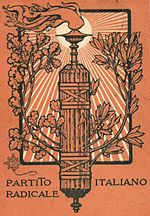Italian Radical Party
Italian Radical Party Partito Radicale Italiano | |
|---|---|
 | |
| Leaders | Ettore Sacchi Francesco Saverio Nitti |
| Founded | 27 May 1904 |
| Dissolved | 26 April 1922 |
| Preceded by | Historical Far Left |
| Merged into | Democratic Liberal Party Italian Social Democratic Party |
| Headquarters | Rome, Italy |
| Ideology | Radicalism[1] Republicanism Secularism Social liberalism Decentralization Anti-clericalism[2] |
| Political position | Centre-left |
| National affiliation | Liberal-Radical lists (1919–1921) |
| Colours | Dark green[3] |
| Part of a series on |
| Radicalism (historical) |
|---|
|
The Italian Radical Party (Italian: Partito Radicale Italiano), also known as the Historical Radical Party (Partito Radicale storico), was a radical, republican, secularist and social-liberal political party in Italy.
History[]
Since 1877, the Radical Party was active as a loose parliamentary group grown out from the Historical Far Left. The group was later organised as a full-fledged party in 1904, under the leadership of Ettore Sacchi. Leading Radicals included Ernesto Nathan (mayor of Rome with the support of the Italian Socialist Party and the Italian Republican Party from 1907 to 1913), Romolo Murri (a Catholic priest who was suspended from his ministry for having joined the party and who is widely considered in Italy the precursor of Christian democracy) and Francesco Saverio Nitti.
The Radicals were originally strong in Lombardy, notably in the northern Province of Sondrio, the southeastern Province of Mantua, northern Veneto and Friuli, Emilia-Romagna, and central Italy, especially around Rome. Later on, they lost votes to the Socialists in Emilia and to the Republicans in Romagna, but strengthened their position in Veneto, notably holding for almost twenty years the single-seat constituencies of Venice and Padua (which had also Radical mayors), and southern Italy, where they were previously virtually non-existent.[4] Thanks to these inroads, the Radicals obtained their best result in the 1913 general election: 10.4% of the vote and 62 seats in the Chamber of Deputies.
With Nitti, a southerner, the Radicals became part of the governing coalition dominated by the Liberals of Giovanni Giolitti, who had positioned his party in the centre-left and supported many Radical reforms, while the Radicals had moved toward the centre. Nitti himself was Minister of the Treasury from 1917 to 1919 and Prime Minister from 1919 to 1920.[5][6] In the 1919 general election, the Radicals filed joint candidates with the Liberals in 54% of the constituencies.[4] For the 1921 general election, they joined forces with several minor liberal parties in order to form the Democratic Liberal Party: the joint list gained 15.9% of the vote and 96 seats, doing particularly well in Piedmont and the South.[4]
After World War II, some former Radicals led by Nitti joined the National Democratic Union, along with the Italian Liberal Party and other elements of the political bloc that governed Italy from the years of Giolitti until the rise of Benito Mussolini's Fascist regime. The Radicals, who were once the far left of the Italian political spectrum, were finally associated with the old Liberal establishment, which was replaced by Christian Democracy as the leading political force in the country. Some left-wing elements of the old Radicals took part to the foundation of the Action Party in 1942, while a new Radical Party was launched in 1955 by the left wing of the Italian Liberal Party. These new Radicals, whose longtime leader was Marco Pannella, claimed to be the ideological successors of the Historical Far Left (Agostino Bertani, Felice Cavallotti, etc.) and the Radicals.[5][6]
Electoral results[]
| Chamber of Deputies | |||||
| Election year | Votes | % | Seats | +/− | Leader |
|---|---|---|---|---|---|
| 1904 | 128,002 (4th) | 8.4 | 37 / 508
|
||
| 1909 | 181,242 (3rd) | 9.9 | 48 / 508
|
||
| 1913 | 522,522 (3rd) | 10.4 | 62 / 508
|
||
| 1919 | 110.697 (7th) | 2.0 | 12 / 508
|
||
Leadership[]
- Secretary: Giovanni Amici (1904–1914), Mario Cevolotto (1919–1920), Gino Bandini (1920–1921), Ernesto Pietriboni (1921–1922)
References[]
- ^ Guerriero, Massimo (2015). Mondadori (ed.). L'ideologia radicale: evoluzione tra gli schieramenti. Le ideologie dei partiti politici. ISBN 9786050381207.
- ^ Orsina, Giovanni (2002). Rubbettino (ed.). Anticlericalismo e democrazia: storia del Partito radicale in Italia e a Roma, 1901–1914. pp. 5–6. ISBN 9788849802948.
- ^ "La campagna elettorale a Roma". La Stampa. 1 June 1914.
- ^ a b c Piergiorgio Corbetta; Maria Serena Piretti (2009). Atlante storico-elettorale d'Italia. Zanichelli: Bologna.
- ^ a b Massimo L. Salvadori (2000). Enciclopedia storica. Zanichelli: Bologna.
- ^ a b David Busato (1996). Il Partito Radicale in Italia da Mario Pannunzio a Marco Pannella.
- Radical parties in Italy
- Political parties established in 1877
- Defunct political parties in Italy
- Critics of the Catholic Church
- Liberal parties in Italy
- Defunct liberal political parties
- 1877 establishments in Italy